
Aëdon was in Greek mythology, the daughter of Pandareus of Ephesus. According to Homer, she was the wife of Zethus, and the mother of Itylus. Aëdon features in two different stories, one set in Thebes and one set in Western Asia Minor, both of which contain filicide and explain the origin of the nightingale, a bird in constant mourning.
In some stories from Greek mythology, Itylus or Itylos was the son of Aedon, who was the daughter of Pandareus of Ephesus and the wife of King Zethus of Thebes.
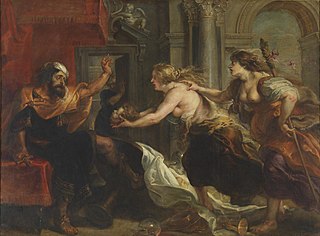
In Greek mythology, Tereus was a Thracian king, the son of Ares and the naiad Bistonis. He was the brother of Dryas. Tereus was the husband of the Athenian princess Procne and the father of Itys.
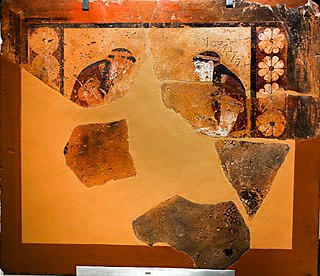
Philomela or Philomel is a minor figure in Greek mythology who is frequently invoked as a direct and figurative symbol in literary and artistic works in the Western canon.
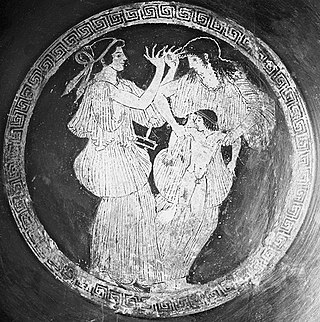
In Greek mythology, Itys is a minor mythological character, the son of Tereus, a king of Thrace, by his Athenian wife Procne. Itys was murdered by his own mother and served to be consumed during dinner by his father, as part of a revenge plan against Tereus for assaulting and raping Philomela, Procne's sister. His immediate family were all transformed into birds afterwards, and in some versions Itys too joins them in the avian kingdom. Itys' story survives in several accounts, the most extensive and famous among them being Ovid's Metamorphoses. His myth had been known since at least the sixth century BC.
In Greek mythology, Pandareus was the son of Merops and a nymph. His residence was given as either Ephesus or Miletus.
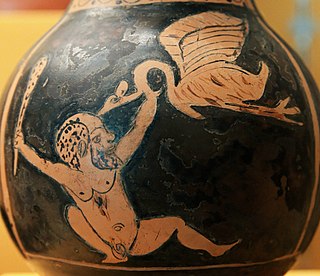
Gerana, sometimes also called Oenoe, is a queen of the Pygmy folk in Greek mythology, who incurred the wrath of the goddess Hera and was subsequently turned into a bird bearing her name, the crane. This aetiological tale explains the ancient rivalry between the Pygmies and the cranes, and also serves as a cautionary tale against the people who hubristically claimed to be better than even the gods themselves. Gerana's story bears some resemblance to that of Lamia, who was also a beautiful woman cursed by Hera and transformed into something unappealing.
Acacallis in Greek mythology, was princess of Crete. The Bibliotheca calls her Acalle (Ἀκάλλη).

Tereus is a lost Greek play by the Athenian poet Sophocles. Although fragments have long been known, the discovery of a synopsis among the Oxyrhynchus Papyri has allowed an attempt at a reconstruction. Although the date that the play was first produced is not known, it is known that it was produced before 414 BCE, because the Greek comedic playwright Aristophanes referenced Tereus in his play The Birds, which was first performed in 414. Thomas B. L. Webster dates the play to near but before 431 BCE, based on circumstantial evidence from a comment Thucydides made in 431 about the need to distinguish between Tereus and the King of Thrace, Teres, which Webster believes was made necessary by the popularity of Sophocles play around this time causing confusion between the two names. Based on references in The Birds it is also known that another Greek playwright, Philocles, had also written a play on the subject of Tereus, and there is evidence both from The Birds and from a scholiast that Sophocles' play came first.

Procne or Progne is a minor figure in Greek mythology. She was an Athenian princess as the elder daughter of a king of Athens named Pandion. Procne was married to the king of Thrace, Tereus, who instead lusted after her sister Philomela. Tereus forced himself on Philomela and locked her away. When Procne discovered her sister and her gruesome fate, she took revenge against her husband by murdering their only child, a young boy named Itys. Procne's story serves as an origin myth for the nightingale.
In Greek mythology, Alcyoneus is a young and handsome man from Crissa, the only son of Diomos and Meganeira. He features in a short myth where he is chosen to be the sacrificial victim for a beast called Sybaris that terrorised Delphi and the surrounding area, a prototypical example of the hero slays a monster and saves a princess tale. His tale survives in the writings of second-century author Antoninus Liberalis, and might originate from an older work by Nicander of Colophon.
In Greek mythology, Pandion may refer to the following characters:
In Greek mythology, Polytechnus is a carpenter from Colophon, in an Anatolian variant of the story of Tereus.

In Greek mythology, Amaleus is the name of the eldest of the Niobids, the twelve or fourteen children of Amphion, king of Thebes, by his wife Queen Niobe. Although the Niobids are primarily notable for the myth of Niobe's blasphemous boast against the goddess Leto, Amaleus has a unique appearance of his own in myth, where an attempt on his life was made by his aunt, Aëdon.
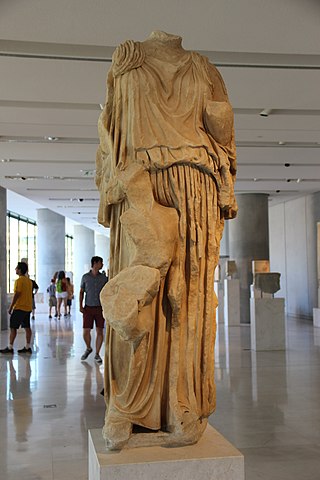
The statue of Procne and Itys is a Greek marble sculpture of the fifth century BC which once adorned the Acropolis of Athens, created by sculptor Alcamenes. The statue depicts the Athenian princess Procne about to strike her own son Itys dead as revenge against her husband Tereus. It was discovered near the temple of Athena-Nike during the early nineteenth century, and it is now exhibited in the Acropolis Museum of Athens, in Greece.
In Greek mythology, Chelidon may refer to the following women:
In Greek mythology, Harmothoë is a minor character, the wife of Pandareus and the mother of his children.
In Greek mythology, Antiphera is a slave woman from Aetolia in the service of Athamas and Ino, a king and queen in Boeotia. Antiphera caught the eye of Athamas, and thus incurred the wrath of his wife Ino.
In Greek mythology, Cleostratus is a teenage boy from Thespiae, a town in Boeotia, who is chosen to be offered to a dragon in a yearly sacrifice to the monster, until he is saved by his lover Menestratus. His and Menestratus's myth is known thanks to Description of Greece, a second-century work by Greek traveller and geographer Pausanias. Cleostratus' myth is an early example of the hero-tale where the hero saves a damsel or princess from a vicious dragon.

In Greek mythology, Cleothera is one of the daughters of Pandareus and Harmothoë, natives of western Asia Minor or the island of Crete. After the deaths of their parents, she and her sister Merope were adopted by Aphrodite, the goddess of love and sensuality, and in time they came to serve the Furies, goddesses of rage and revenge.












